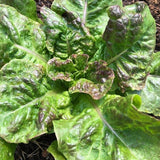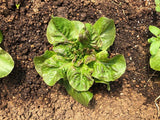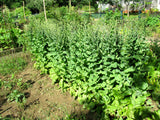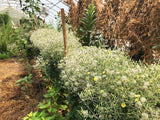Eva Snader's Brown Winter Lettuce
Lactuca sativa
Eva Snader's Brown Winter Lettuce is a winter hardy lettuce with delicious, crispy, bronzed leaves. We would plant it in September or November and harvest in early spring. Dr. William Woys Weaver received the seeds from Lisa Von Saunder from Amishland Seeds, who had gotten them from her friend, neighbor, and mentor Ms. Snader, who’d been growing it and selling it at an Ephrata farmers market for 50 years, and whose family had grown it for at least 5 generations in Schoeneck, Lancaster County, Pennsylvania. Dr. Weaver told Ms. Saunder that "it appears to be a local selection of the black-seeded Brown Dutch Winter (Laitue brune de Hollande) introduced into the US as a forcing lettuce during the 1860s."
Days to maturity: Overwinter
Seeds per pack: 100
Germination rate: 96% on 05/27/2025
Planting / harvesting notes
Seed every 1" in rows 8-12" apart, 1/4-1/2" deep. Keep watered until germination. Thin to every 8". Harvest when you can't wait anymore!
Seed keeping notes
Lettuce is very much self-pollinating, but give at least 10 feet between plants (we give at least 35 feet) to avoid unwanted cross-pollination from flying insects. Allow the plants to bolt and flower. Often, flowering lettuce benefits from simple staking (we tie several plants together) so that the flowers and seedheads do not fall to the ground. Seed is ripe when the flowers turn to 'feathers', which are fluff balls like dandelions. In the moist summers of Pennsylvania, we harvest the entire seedheads when at least 50% of the plant has gone to seed. If there are dry days in the forcast, feel free to wait longer for more ripe seed. Cut the seedheads a few feet down, and allow to dry about a week in a sunny dry place like a greenhouse, sunny window, or even a car seat. Later, wearing a handkerchief or mask to avoid breathing in the feathers and dust, bang the seedheads in a bucket allowing the seed to fall to the bottom. The ripest seeds fall, the least ripe stay in the plant, so do not over do it. Sift through strainers to remove the large chaff, and then use your breath, a fan, or the wind to carefully blow off the smaller dust.











